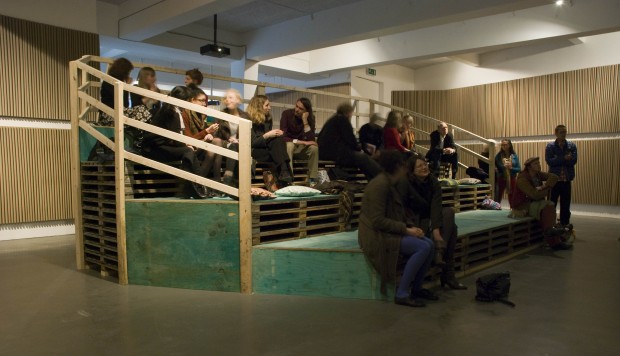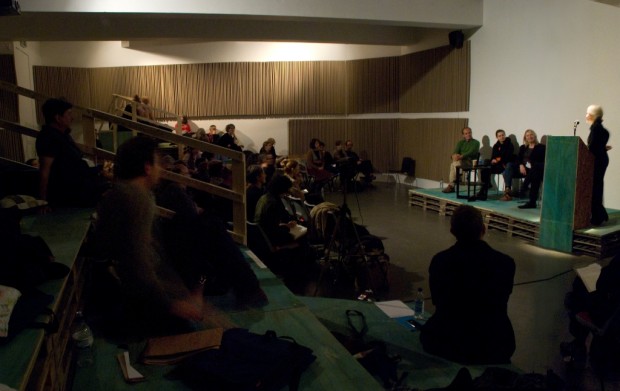Transformation of The Exchange
Abigail Reynolds worked with volunteers to transform the gallery space at The Exchange for The Penzance Convention and to construct the cinematic environment for the Extraction: Projection exhibition. Entitled Extraction/ Exchange, the installation referred to disparate sources, from picture palaces to modernist architecture, as well as bringing in local references such as Gwennap Pit and the Minack Theatre. Reynolds used materials close-to-hand, easy to work and universally available: pallets, corrugated cardboard, recycled wood. The plywood donated by a building firm had been treated with a copper-based preservative to protect it from rot and infestation; the green of the copper salts was assimilated into her design.

Starting with a seating bank for the Extraction: Projection exhibition, the installation was later expanded for the three-day conference, The Penzance Convention.

Abigail Reynolds was asked to undertake this commission partly as a means of addressing The Exchange gallery’s harsh acoustics. She worked closely with the form and acoustics of the space to soften both, aiming for a space that would feel intimate, familiar, muted, and convivial. Her installation was designed as a container for the works shown.
Fluted cardboard panels rounded off the corners of the gallery, repeating the dimensions and angle of the back left corner of the gallery. This device further softened the acoustics, preventing sound from bouncing into the corners of the space.
In addition to their functional attributes, Abigail Reynolds notes that the fluted cardboard wall panels evoked a wide range of visual sources, conscious and unconscious: ‘from El Lissitzky’s exhibition designs and his walls at the Van Abbemuseum in Eindhoven to the wooden screens in Tudor houses (Lanhydrock has one with a linen fold design), picture palace interiors of the 1930s, perhaps the interiors of the concert halls in the Barbican and Queen Elizabeth Hall. Shigeru Ban and the Finnish pavilion by Alvar Aalto at the New York World Fair, 1938-39 are also implicated. In retrospect, the Alvar Aalto pavilion is key. That’s in wood. I’ve been wanting to work with it as a display mechanism, but it has surfaced like this instead.’
Reynolds has worked on large sculptures for public galleries, (most notably with corrugated cardboard for the sculpture Mount Fear in 2002) and on tiny folding collages. She enjoys these discontinuities in scale. For the last five years she has focused on working with photographs found in books, folding them together, and has also brought events to Assembly in St Just, a converted chapel in which she hosts residencies. ‘Slow Time’ is an ongoing series of interdisciplinary talks focusing on time in the creative process.
She sees the installation Extraction/Exchange as fitting within the continuum of her practice, relating to her interest in ‘drawing together disparate elements in an exchange – the form of the collage, the form of the discussion. This includes the fold as a formal and philosophical decision.’
Some twenty volunteers helped to make the installation. Wall panels were constructed from folded corrugated cardboard. Platforms for seating were built from pallets and recycled plywood by gallery technicians Nick Brierley and Roger Weisman. The cushions and curtains were sewn in group sessions at The Exchange organised by Kirsty Lowry and led by Ann Haycock. The fabric was all donated.

